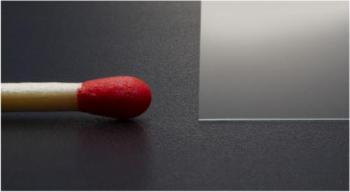AGC has developed the world’s thinnest sheet glass that measures 0.1 mm. The ultra-thin glass was developed using the float process and was produced from alkali-free glass, which comprises aluminum oxide, boron oxide and silicon dioxide and is free from alkaline substances like potassium and calcium.
 AGC's ultra-thin sheet glass
AGC's ultra-thin sheet glass
The ultra-thin sheet float glass has potential applications in touchscreens, lighting, displays and other devices.
The major transition towards OLED lighting and thin displays has increased the demand for various glass materials, including glass substrates for flexible displays and cover glass and glass substrates for touchscreen panels. AGC’s thin sheet glass can be used in displays and touch screens as it provides several benefits. It is lightweight and has more flexibility. Other benefits include resistance to gases, chemicals and heat, electrical insulation and transparency.
For over five years, AGC has been producing 0.4 mm alkali-free glass that is used as a glass substrate in TFT-LCDs. As a step forward, the company has reduced the thickness to 0.3 mm and in April 2011, started distributing 0.28 mm thin soda-lime glass substrate for use in touchscreens.
The company showcased the thinnest sheet glass at Display Week 2011, scheduled on May 17 in Los Angeles, California.